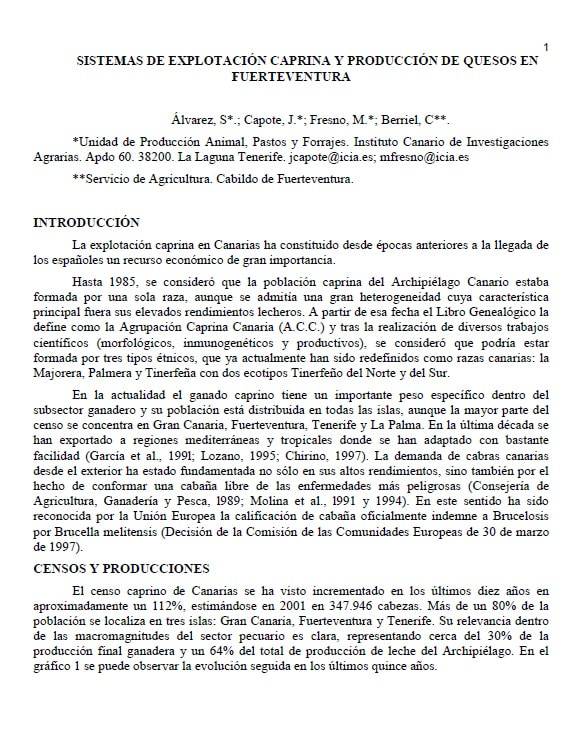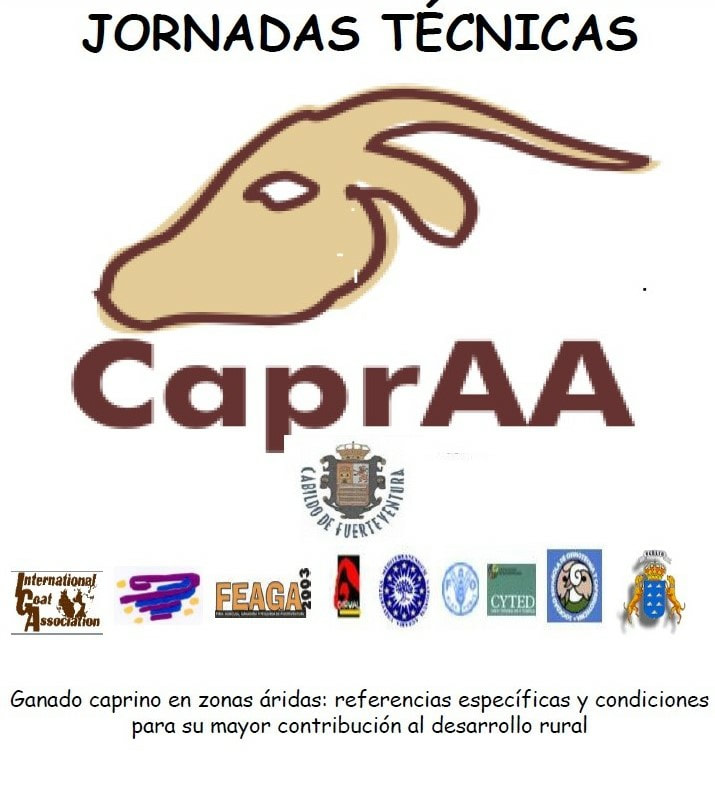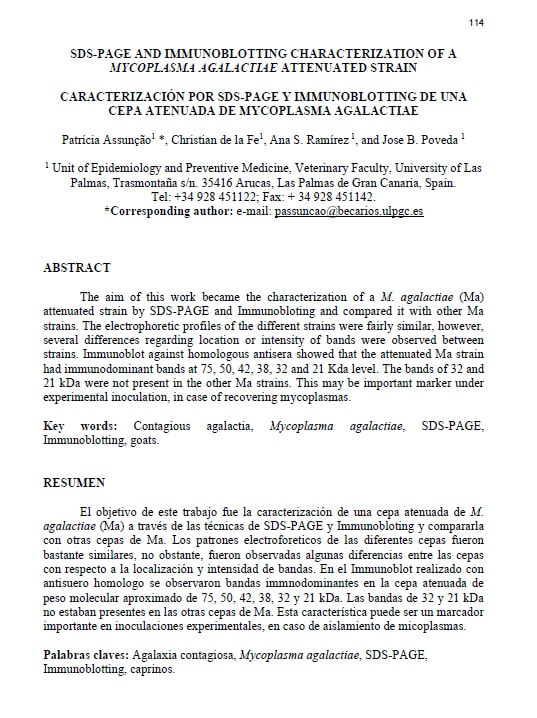April 3-6, 2003, Fuerteventura, Canary Islands
Goats in Arid Areas - IGA Regional Conference
Download the important papers from this IGA regional conference.
Report of the Regional Conference in Fuerteventura (April 2003)
GOATS IN ARID AREAS: specific references and conditions for their increased contribution in rural development
The CaprAA International technical meeting was held in Fuerteventura (Canary Islands) in late April, 3rd to 6th under the auspices of the International Goat Association and organised by the Canarian Institute of Agricultural Research (ICIA) with the support of CIHEAM, CIRVAL, FAO and SEOC and the local government (Cabildo) of Fuerteventura. The stakes on the future of animal production in arid areas are important and related with sustainable development. The objective of this meeting was to evaluate what could be the role of goats to strengthen such a development and in what conditions.
Methodologies to evaluate the efficiency of goat production systems, the organisation of goat development and priorities were presented in the main communications and discussed during the round tables.
Improvement of specific goat nutrition techniques for arid zones has to be promoted.
The goat nutrition methods have been perfected for intensive production systems and can hardly been applied for extensive systems and particularly under arid conditions. These methods have been established with sheep and if digestibility of a good forage would be similar for sheep and goat, it would be different for bad quality ones. Beyond, we have few references on forage ingestion in arid areas and range vegetation is known to contain anti-nutritional factors and tannins. Heat stresses would also reduce food ingestion, interaction between forage and concentrates is not well known. All these elements would make difficult to calculate food ration with such methods.
The method of lowerback and sternal estimation of body score at several physiological stages and according to the herd potential would be a way to identify the nutrition state of the animal (under - nutrition or over-nutrition) and to know indirectly the quality of rangelands used by goats.
The local ancient pasture practices were a way to secure livestock management towards climatic uncertainty. The actual changes could lead to loss of this knowledge that has to be preserved.
Actions on goat nutrition have to be a priority for development in arid areas. Several low cost solutions exist to improve the goat nutrition on pasture as, for instance, distribution of locally made mineral blocks with ashes and quicklime (to deactivate phenolic anti-nutritional factors). In Tunisia where these techniques have been developed animals could intake 100 to 300g each day (Bensalem).
Genetic improvement: No conditions to develop selection of goat local breeds in developing countries.
At the opposite, it is very hard to get enough financial means for selection as the importance of goats in the GNP are generally low and the social role of goats is generally not considered. Consequently most of the genetic improvement projects have limited means and for short periods.
This realty is not compatible with the necessary conditions for animal selection: logistics to co-ordinate the actions, perennial and well defined financial support, definition of precise objectives that would have to be adapted to the arid areas, basic training and active participation of breeders.
These conditions generally do not exist in arid areas where there is generally not long terms politics on training and extension (few identification, few laboratories and thus no generalised animal recording). Goat is a small size animal and the rule is that the price of controls must not go beyond the price of the product.
Rather than to organise heavy selection centres with few chance of success and a low impact of global performances, it is proposed to give a priority on selection within the herds. Beyond the creation of genetic nucleus to preserve local breeds and biodiversity could be very useful (Delgado).
Very few efficient extension services on goats.
All the case studies confirm that extension services on goats in arid areas have specific conditions. Social or economical problems are always associated with technical considerations. Many examples were given on the situation in Argentina, Bolivia, Mexico, Tunisia. Goat farmers have nearly no regular assistance or extension in most of the countries. In Tunisia, the associative approach is a priority, and scientists are asked to be involved in technology transfer and training with an evaluation of the impact of research on development. In other countries like in Mexico, the specialised goat breeders have created Associations but small village farmers have few services except punctual actions lead by official extension services.
In fact, there is no real strategy for goats. All participants have considered that they would have to be different from the specialised services of developed countries. More than other animals, goats are emblematic of village small scale agriculture and services must not be specialised. The transfer of models, from developed countries to arid areas, would have to be considered very carefully. Co-operative approaches are recommended to associate technicians, breeders, scientists and deciders. Investment on goats is still very low with limited means for extension or research on goats. The projects are generally not co-ordinated and lead with support of Non Governmental Organisations in relation with social objectives.
Conclusions and recommendations: For a mobilisation to promote goats in arid areas.
The general conclusions of the meeting were agreed by all participants. All insisted on the relation between goat and social development of rural zones. A specific research on goats in arid areas has to be promoted to get local references.
With voluntarism a awareness is necessary to promote access of small farmers to investment.
To reinforce the professional or scientific international networks, now without much financial support could be indispensable to be dynamic. The Canarian region and Fuerteventura Island are sensitised both on goats and arid conditions. They could become a permanent place for meetings and exchanges.
GOATS IN ARID AREAS: specific references and conditions for their increased contribution in rural development
The CaprAA International technical meeting was held in Fuerteventura (Canary Islands) in late April, 3rd to 6th under the auspices of the International Goat Association and organised by the Canarian Institute of Agricultural Research (ICIA) with the support of CIHEAM, CIRVAL, FAO and SEOC and the local government (Cabildo) of Fuerteventura. The stakes on the future of animal production in arid areas are important and related with sustainable development. The objective of this meeting was to evaluate what could be the role of goats to strengthen such a development and in what conditions.
Methodologies to evaluate the efficiency of goat production systems, the organisation of goat development and priorities were presented in the main communications and discussed during the round tables.
Improvement of specific goat nutrition techniques for arid zones has to be promoted.
The goat nutrition methods have been perfected for intensive production systems and can hardly been applied for extensive systems and particularly under arid conditions. These methods have been established with sheep and if digestibility of a good forage would be similar for sheep and goat, it would be different for bad quality ones. Beyond, we have few references on forage ingestion in arid areas and range vegetation is known to contain anti-nutritional factors and tannins. Heat stresses would also reduce food ingestion, interaction between forage and concentrates is not well known. All these elements would make difficult to calculate food ration with such methods.
The method of lowerback and sternal estimation of body score at several physiological stages and according to the herd potential would be a way to identify the nutrition state of the animal (under - nutrition or over-nutrition) and to know indirectly the quality of rangelands used by goats.
The local ancient pasture practices were a way to secure livestock management towards climatic uncertainty. The actual changes could lead to loss of this knowledge that has to be preserved.
Actions on goat nutrition have to be a priority for development in arid areas. Several low cost solutions exist to improve the goat nutrition on pasture as, for instance, distribution of locally made mineral blocks with ashes and quicklime (to deactivate phenolic anti-nutritional factors). In Tunisia where these techniques have been developed animals could intake 100 to 300g each day (Bensalem).
Genetic improvement: No conditions to develop selection of goat local breeds in developing countries.
At the opposite, it is very hard to get enough financial means for selection as the importance of goats in the GNP are generally low and the social role of goats is generally not considered. Consequently most of the genetic improvement projects have limited means and for short periods.
This realty is not compatible with the necessary conditions for animal selection: logistics to co-ordinate the actions, perennial and well defined financial support, definition of precise objectives that would have to be adapted to the arid areas, basic training and active participation of breeders.
These conditions generally do not exist in arid areas where there is generally not long terms politics on training and extension (few identification, few laboratories and thus no generalised animal recording). Goat is a small size animal and the rule is that the price of controls must not go beyond the price of the product.
Rather than to organise heavy selection centres with few chance of success and a low impact of global performances, it is proposed to give a priority on selection within the herds. Beyond the creation of genetic nucleus to preserve local breeds and biodiversity could be very useful (Delgado).
Very few efficient extension services on goats.
All the case studies confirm that extension services on goats in arid areas have specific conditions. Social or economical problems are always associated with technical considerations. Many examples were given on the situation in Argentina, Bolivia, Mexico, Tunisia. Goat farmers have nearly no regular assistance or extension in most of the countries. In Tunisia, the associative approach is a priority, and scientists are asked to be involved in technology transfer and training with an evaluation of the impact of research on development. In other countries like in Mexico, the specialised goat breeders have created Associations but small village farmers have few services except punctual actions lead by official extension services.
In fact, there is no real strategy for goats. All participants have considered that they would have to be different from the specialised services of developed countries. More than other animals, goats are emblematic of village small scale agriculture and services must not be specialised. The transfer of models, from developed countries to arid areas, would have to be considered very carefully. Co-operative approaches are recommended to associate technicians, breeders, scientists and deciders. Investment on goats is still very low with limited means for extension or research on goats. The projects are generally not co-ordinated and lead with support of Non Governmental Organisations in relation with social objectives.
Conclusions and recommendations: For a mobilisation to promote goats in arid areas.
The general conclusions of the meeting were agreed by all participants. All insisted on the relation between goat and social development of rural zones. A specific research on goats in arid areas has to be promoted to get local references.
With voluntarism a awareness is necessary to promote access of small farmers to investment.
To reinforce the professional or scientific international networks, now without much financial support could be indispensable to be dynamic. The Canarian region and Fuerteventura Island are sensitised both on goats and arid conditions. They could become a permanent place for meetings and exchanges.



